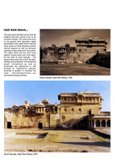Contribute
| In Conversation With Dr. Minakshi Jain, Conservationist |
Nirmala Garimella
06/22/2009
Heritage – A word that conjures up an image of culture, values, something handed down from one's ancestors or the past, as a characteristic, tradition, etc. will appreciate the efforts of conservationists who work hard to preserve these traditions. In the case of conservation of ancient architectural forts particularly of Rajasthan, India, Prof Minakshi Jain and her husband Prof K.B.Jain hold a significant place. As an architect and director for the conservation of the Ahichhatragarh-Nagaur Fort in northwest India she has established how a previously dilapidated fort can become a model for the conservation of historic sites. The project was also a recipient of UNESCO's Award for Excellence in Cultural Heritage Conservation and was recognized for setting new conservation standards by combining modern scientific techniques with traditional building methods. Ms. Jain was in Boston recently while presenting an open lecture entitled "Conservation of the Ahichhatragarh-Nagaur Fort in India" on March 19, 2009 at Los Angeles. A partner in the firm, Jain Associates in Ahmedabad along with Prof. K.B. Jain, she has authored "Indian Cities in the Arid West" (1994); "Architecture of the Indian Desert (2000) and "Thematic Space in Indian Architecture" (2002). She also teaches at the School of Architecture, CEPT University, Ahmedabad. We met her at her sister’s home in Belmont where she shared with us an amazing interactive digital multimedia installation called the ‘Eye of Nagaur’, a film on Nagaur Fort as well as talked about the various stages of its restoration. Tell us about your initial introduction to the Nagaur project? Give us a background of the Nagaur Fort? Begun in the 12th century on the remains of a fourth-century mud outpost and standing at the crossroads of developing trade routes, the fort was expanded by successive rulers until the mid-18th century. Today, after a dramatic transformation, it is a 35-acre complex with four main palaces and over 50 smaller buildings, surrounded by two fortification walls and—despite the arid climate—by extensive gardens, fountains, pools, and water systems. What were the challenges to the restoration? There are always many challenges but we deal with them. First to find its historic status, to find clues for foot prints, and to find historic materials and workers. There was a communication gap with the workers who worked on the ground since the instructions were in English and we needed to translate them verbally to Hindi. The local workers have to be taught not to simply make a beautiful structure but to adhere to the traditional / historic designs. We always had to ask them to make a sample first. Work is slow so you need a lot of patience. The use of lime is must, so that posed another challenge on how to use it. I live in Ahmadabad but I would make periodic trips to Jodhpur to oversee the project. You came to University of Pennsylvania to study architecture in the late 60’s. Tell us about your time here and your association with Loius Kahn the famous architect. How is conservation and architecture learning in India perceived? I have been teaching for 30 years and at our school, each teacher is free to teach how they want. Students can pursue what they want to do within the architecture framework. In terms of conservation, the government is interested at both the state and central level. In varying degrees. Right now I am working on the Dandi project of Gandhi’s 23 day march, we are trying to recreate the walk. I think that conservation efforts allow the chance to bring back what was lost to the people and that is definitely an achievement.
You may also access this article through our web-site http://www.lokvani.com/
